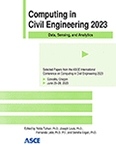Feasibility Analysis on the Use of NLP-Based Schedule Analytics for 4D Project Planning and Controls
Publication: Computing in Civil Engineering 2023
ABSTRACT
4D (3D + time) building information modeling (BIM) brings important benefits to the practice of project planning and controls in construction. Despite well-documented benefits, the level of technical effort necessary to create 4D BIM by manually tying in BIM elements with schedule activities has been a significant barrier to its wider adoption. To address it, this paper explores the possibility of identifying <object, location, responsible party, means&method> in each schedule activity based on ASTM’s Uniformat classification and then automatically mapping it to the most relevant BIM elements in its corresponding work location. Specifically, the feasibility of training a transformer-based natural language processing model to infer Uniformat classification of a schedule activity is explored. Results from testing the proposed model on four real-word project schedules show the potential for a path forward toward automated 4D BIM creation. Insights from the performance of this model and a path forward for model improvements are discussed.
Get full access to this article
View all available purchase options and get full access to this chapter.
REFERENCES
Altun, M., and Akcamete, A. (2018). “A method for facilitating 4d modeling by automating task information generation and mapping.” Proc. 35th CIB W78, 479–486.
Amer, F., and Golparvar-Fard, M. (2019). “Automatic understanding of construction schedules: Part-of-activity tagging.” EC3 Conference 2019, Vol. 1, 190–197.
Amer, F., and Golparvar-Fard, M. (2021). “Modeling dynamic construction work template from existing scheduling records via sequential machine learning.” Adv. Eng. Inf., 47, 101198.
Ciribini, A., Mastrolembo Ventura, S., and Paneroni, M. (2016). “Implementation of an interope-rable process to optimise design and construction phases of a residential building: A bim pilot project.” Autom. Constr., 71, 62–73.
CSI. (2016a). “Masterformat, <http://www.csinet.org/Home-Page-Category/formats/masterformat>(March. 20, 2023).
CSI. (2016b). “Uniformat, <http://www.csinet.org/Home-Page-Category/formats/uniformat>(March. 20, 2023).
Devlin, J., Chang, M., Lee, K., and Toutanova, K. (2018). “BERT: pre-training of deep bidirectional transformers for language understanding.”, abs/1810.04805.
Doukari, O., Seck, B., and Greenwood, D. (2022). “Creation of construction schedules in 4d bim: Comparison of conventional and automated approaches.” Buildings, 12(8).
Gledson, B., and Greenwood, D. (2016). “Surveying the extent and use of 4d bim in the uk.” J. Inf. Technol. Construct., 21, 57–71.
Kassem, M., Brogden, T., and Dawood, N. (2012). “Bim and 4d planning: a holistic study of the barriers and drivers to widespread adoption.” J. Constr. Eng. Project Manage., 2(4), 1–10.
Kingma, D. P., and Ba, J. (2014). “Adam: A method for stochastic optimization.” arXiv preprint arXiv:1412.6980.
Lin, J. J., and Golparvar-Fard, M. (2021). “Visual and virtual production management system for proactive project controls.” J. Constr. Eng. Manage., 147(7), 04021058.
Liu, H., Al-Hussein, M., and Lu, M. (2015). “Bim-based integrated approach for detailed construction scheduling under resource constraints.” Autom. Constr., 53, 29–43.
Mekala, D., Gangal, V., and Shang, J. (2021). “Coarse2fine: Fine-grained text classification on coarsely-grained annotated data”. arXiv preprint arXiv:2109.10856.
Montaser, A., and Moselhi, O. (2015). “Method for automated generation of 4d bim”. Proc., ICSC15, Vancouver, Canada. June 7-10.
Osment, M., and Bowles, J. (2021). Breaking down the barriers to 4d adoption in construction. 3D Repo, 1–17.
Park, J., and Cai, H. (2015). “Automatic construction schedule generation method through bim model creation.” Proc. Computing in Civil Eng. 2015, 620–627.
Park, J., and Cai, H. (2017). “Wbs-based dynamic multi-dimensional bim database for total construction as-built documentation.” Autom. Constr., 77, 15–23.
Radford, A., Wu, J., Child, R., Luan, D., Amodei, D., and Sutskever, I. (2019). “Language models are unsupervised multitask learners.” OpenAI blog, 1(8), 9.
Silveira, B. F., and Costa, D. B. (2023). “Method for automating the processes of generating and using 4d bim models integrated with location-based planning and last planner® system.” Construction Innovation, (ahead-of-print).
Torres-Calderon, W., Chi, Y., Amer, F., and Golparvar-Fard, M. (2019). “Automated mining of construction schedules for easy and quick assembly of 4d bim simulations.” Proc., Computing in Civil Engineering 2019, ASCE, 432–438.
Tulke, J., and Hanff, J. (2007). “4d construction sequence planning–new process and data model.” Proc. of CIB-W78 24th, 79–84.
Information & Authors
Information
Published In
History
Published online: Jan 25, 2024
ASCE Technical Topics:
- Analysis (by type)
- Architectural engineering
- Building information modeling
- Building management
- Buildings
- Business management
- Construction engineering
- Construction management
- Engineering fundamentals
- Feasibility studies
- Management methods
- Methodology (by type)
- Models (by type)
- Practice and Profession
- Project management
- Research methods (by type)
- Scheduling
- Structural engineering
- Structures (by type)
- Three-dimensional analysis
- Three-dimensional models
Authors
Metrics & Citations
Metrics
Citations
Download citation
If you have the appropriate software installed, you can download article citation data to the citation manager of your choice. Simply select your manager software from the list below and click Download.
